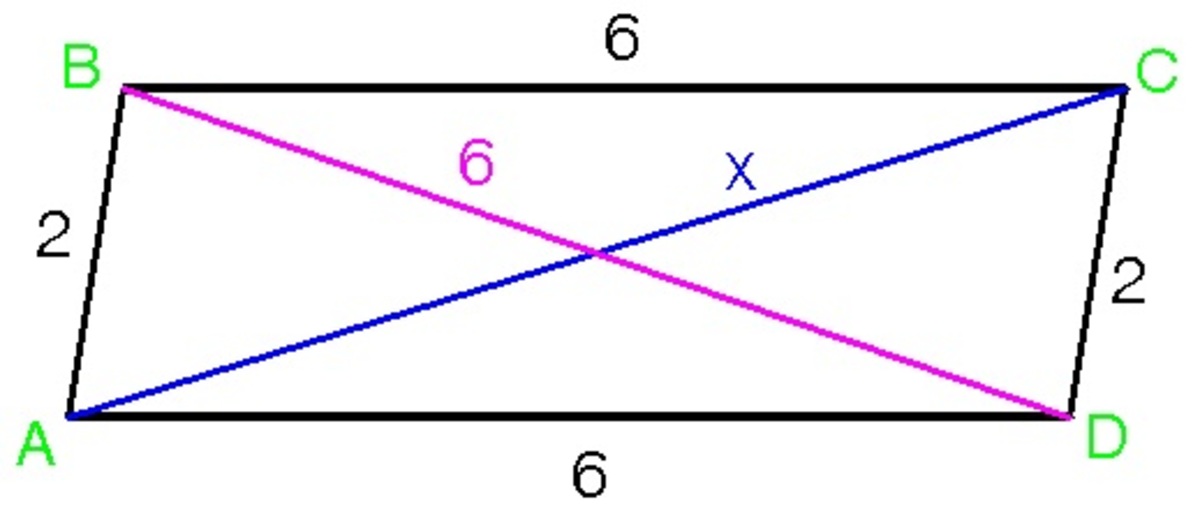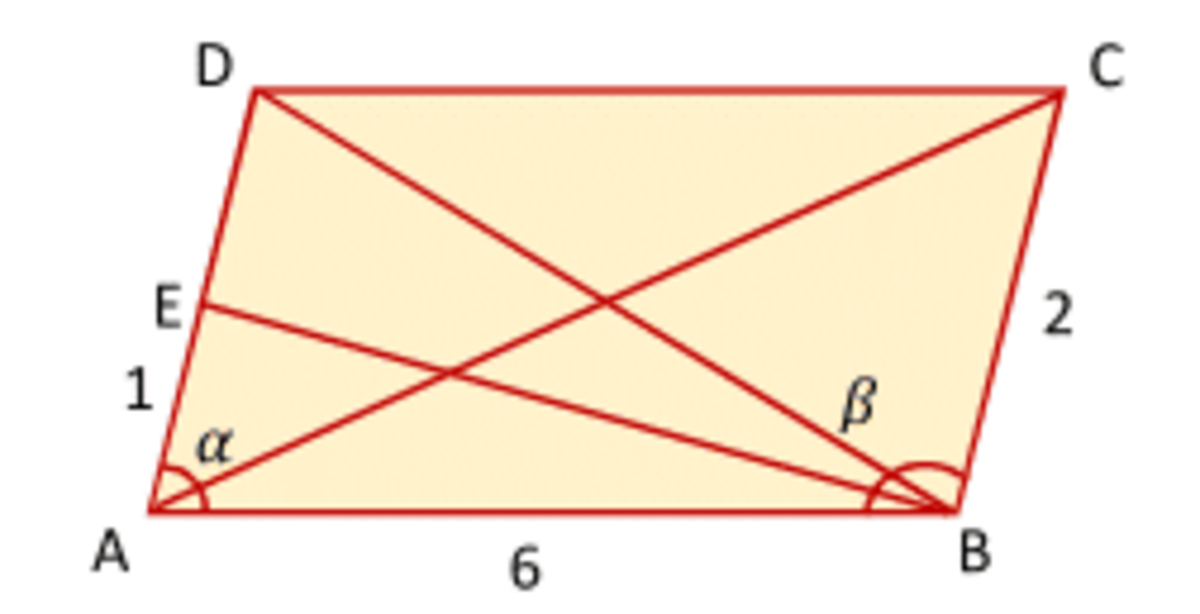A geometry problem by Julian Yu
A parallelogram, with sides measuring 2 and 6, has its shorter diagonal also measuring 6. If the length of the longer diagonal is x , find x 2 .
The answer is 44.
This section requires Javascript.
You are seeing this because something didn't load right. We suggest you, (a) try
refreshing the page, (b) enabling javascript if it is disabled on your browser and,
finally, (c)
loading the
non-javascript version of this page
. We're sorry about the hassle.
4 solutions
Without Cosine Rule, The Relation Between The Diagonals & Sides Of A Parallelogram Is: 2 ( A B ) 2 + 2 ( B C ) 2 = ( A C ) 2 + ( B D ) 2 ⟹ 2 ( 2 2 ) + 2 ( 6 2 ) = 6 2 + x 2 ⟹ x 2 = 4 4
The proof of this relation is through the Apollonius theorem. Applying Apollonius theorem on the 2 triangles of the parallelogram and adding the 2 results gives us the above fact.( U also have to use the fact that the diagonals bisect each other in equal lengths.)
 Considering triangle ABD:
Considering triangle ABD:
By Cosine Law
6 2 = 2 2 + 6 2 − 2 ( 2 ) ( 6 ) c o s A
∠ A = 8 0 . 4 0 5 9 3 1 7 7 ∘
It follows that,
∠ B = ∠ D = 2 3 6 0 − 2 ( ∠ A ) = 2 3 6 0 − 2 ( 8 0 . 4 0 5 9 3 1 7 7 ) = 9 9 . 5 9 4 0 6 8 2 3 ∘
Considering triangle ACD:
By Cosine Law
x 2 = 2 2 + 6 2 − 2 ( 2 ) ( 6 ) c o s 9 9 . 5 9 4 0 6 8 2 3 = 4 4
 △
A
E
B
is a right triangle, so
cos
α
=
6
1
.
△
A
E
B
is a right triangle, so
cos
α
=
6
1
.
β = 1 8 0 ∘ − α therefore cos β = − c o s α = − 6 1
From △ A B C using law of cosines A C 2 = x 2 = 6 2 + 2 2 − 2 × 6 × 2 × cos β = 3 6 + 4 + 4 = 4 4
Let the parallelogram be A B C D as shown in the diagram. Then the shorter diagonal is A C and the longer diagonal is B D . Let ∠ B A C = ∠ A C D θ . Then by cosine rule , we have:
∣ B D ∣ 2 x 2 = ∣ A B ∣ 2 + ∣ A D ∣ 2 − 2 ∣ A B ∣ ∣ A D ∣ cos ∠ B A D = 6 2 + 2 2 − 2 ( 6 ) ( 2 ) cos ( ∠ B A C + ∠ C A D ) = 4 0 − 2 4 cos ( θ + 2 1 8 0 ∘ − θ ) = 4 0 − 2 4 cos ( 9 0 ∘ + 2 θ ) = 4 0 + 2 4 cos ( 9 0 ∘ − 2 θ ) = 4 0 + 2 4 sin 2 θ = 4 0 + 2 4 × 6 1 = 4 0 + 4 = 4 4 Note that △ A C D is isosceles. Note that cos ( 1 8 0 ∘ − x ) = − cos x Note that cos ( 9 0 ∘ − x ) = sin x Note that sin 2 θ = 6 1